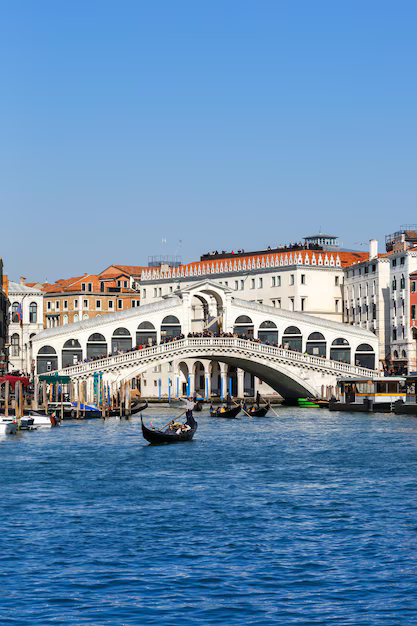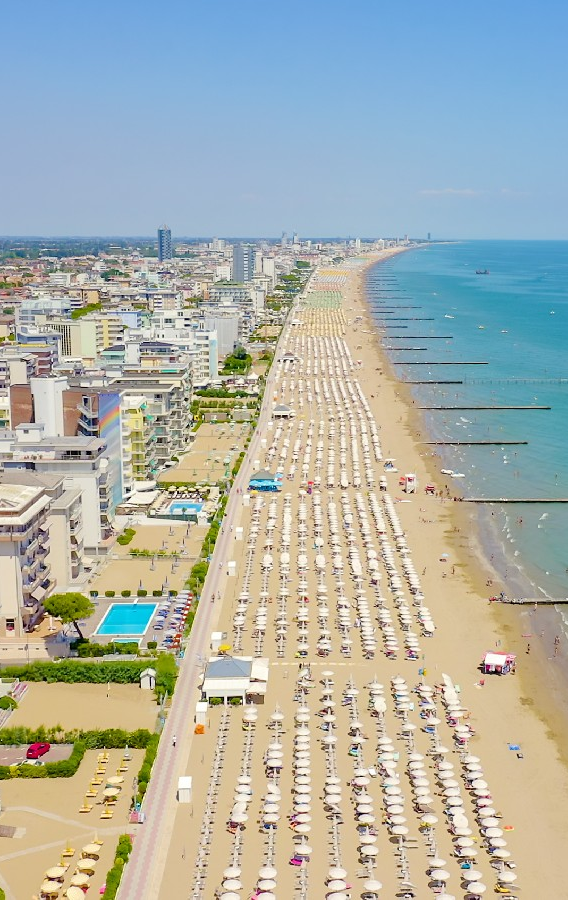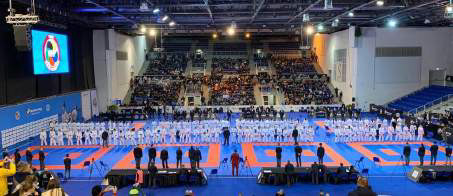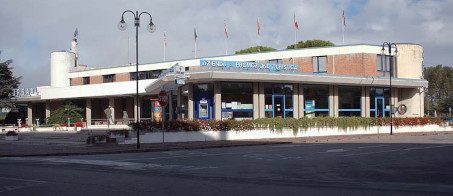

It is an incredible city that you can explore either on foot or by boat and that's made up of 118 islands joined by more than 400 bridges and separated by canals which act as streets. It is also fascinating for the many art treasures that it holds: churches, palaces, museums, bridges: we can almost say that the entire city is a unique work of art built throughout centuries that continually faces the difficulties spurred by the lagoon's unstable nature.
Venice is in itself a work of art, an authentic box of art treasures coming from all around the world. Travelling along the Canal Grande on a boat will be an unforgettable experience that will allow you to admire the refined palaces and the wonderful churches. Then there's the heart of Venice, St. Mark's square, one of the most beautiful places in the world with the marvelous Basilica, the Campanile and the Ducal Palace…
The works of art that are kept in the churches and museums, but also the less wellknown places that you may come across as you walk between bridges and squares, are incredibly fascinating and full of charm.

When in the fifth century a.C. the barbarians invaded the Po Valley, the people took refuge on the islands of the lagoon. After this episode, about 421 a.C., Venice was founded. The city developed around one of the oldest centres, Rialto, and quickly became a rich merchant harbour, an important link between the west and east markets. At the end of the thirteenth century Marco Polo started to trade with China, though the Serenissima Republic with its institutional system based on the "dogato" was already spreading towards the mainland thus starting centuries of prosperity and of shrewd government. The decline arrived in the sixteenth century when the trade routes to America were moved and begun to favour the Atlantic harbours. In 1797 Napoleon conquered the city and gave it over to Austria; Venice stayed under the Hapsburg rule up to 1866 when it became part of the Italian kingdom.
Jesolo was originally a lagoon in which appeared many little isles.
The isle called by the Romans “Equilium” was the biggest one: the ancient group of people who inhabited this area (Paleoveneti) were famous all over the world as horse breeders and the toponym seems indeed to refer to these noble animals. Thanks to the help of Rome, the Paleoveneti managed to chase away the Gaules and, in exchange for protection, they allowed them to settle down pacifically in the modernday Veneto region.
The Romans colonized these territories, and they built streets, bridges and villages. They introduced their method of land measurement (known as Roman grid) and they made the soil arable by reclaiming swamp areas.

However, the fall of the Roman Empire brought insecurity: the Vikings finally managed to cross the border and invaded the land. The backcountry population found safe shelter into the lagoon and started the foundation of new settlements. In particularly Eraclea was founded by the inhabitants of Oderzo on the isle Melidissia and Jesolo on the isle Equilio.
Thanks to its strategic position, Jesolo was at the centre of the North-Adriatic maritimetrade. Protected by the lagoon, the village could spread undisturbed up to become episcopal seat.
In 1866 Jesolo was annexed to the Italian Reign. However, the situation did not improve and during the 1st World War Cavazucchina was damaged, and people had to flee away. Peace after the war allowed the village reconstruction. The biggest land reclamation work was realised between 1920-1930: cultivation of wheat, corn, beet, fruit trees and vineyards were introduced. In 1930 the city was denominated with its ancient name, Jesolo, and from 1936 Marina Bassa and Spiaggia took the name of Lido di Jesolo.






No coach can register if he/she is not in possesion of the EKF Kumite and/or Kata Coach certification level.
After passing the document and accreditation check, the representatives will continue to Sportdata to confirm their entries. Registration will be arranged at the Kursaal Congress Center foyer on Monday, 7th October 2024, from 10:00 to 18:00 hrs and on Tuesday, 8th October 2024, from 09:00 to 14:00 hrs
From 09:00 to 14:00 Weigh-in for Male categories
From 10:00 to 12:00 Weigh-in for Male categories
From 12:00 to 13:30 Weigh-in for Female categories
Kata Eliminations Male / Female UNDER -21
Kata Team Eliminations Male / Female CADET/JUNIOR
Kata Repechages Individual -21 & Teams
Kumite -60 -67 -75 -84 +84 Kg Male Under -21
Kumite -50 -55 -61 -68 +68 Kg Female Under -21
Kumite Repechages Male / Female Under -21
From 10:00 to 12:00 Weigh-in for Male categories
From 12:00 to 13:30 Weigh-in for Female categories
Kata Eliminations Male / Female JUNIORS
Kata Repechages Male / Female JUNIORS
Kumite -55 -61 -68 -76 +76 Kg Male JUNIORS
Kumite -48 -53 -59 -66 +66 Kg Female JUNIORS
Kumite Repechages Male/Female JUNIORS
Kata Eliminations Male / Female CADETS
Kata Repechages Male / Female CADETS
Kumite -52 -57 -63 -70 +70Kg Male CADETS
Kumite -47 -54 -61 +61 Kg Female CADETS
Kumite Repechages Male/Female CADETS
10.00 - 10.20 Kata Bronzes Female / Male Cadet
10.20 - 11.05 Kumite Bronzes Female / Male Cadet
11.15 - 11.35 Kata Individual Female - Male Cadet
11.35 - 11.50 Medal Awards
11.50 - 12.05 Kumite .- 52, - 57, - 63 Kg Male Cadet
12.05 - 12.20 Medal Awards
12.20 - 12.35 Kumite .- 47, - 54, - 61 Kg Female Cadet
12.35 - 12.50 Medal Awards
12.50 - 13.05 Kumite +61, - 70, + 70 Kg Female & Male Cadet
13.05 - 13.20 Medal Awards
15.00 - 15.20 Kata Bronzes Female / Male Junior
15.20 - 16.20 Kumite Bronzes Female / Male Junior
16.30 - 16.50Kata Individual Female - Male Junior
16.50 - 17.05Medal Awards
17.05 - 17.25Kumite .- 55, - 61, - 68 Kg Male Junior
17.25 - 17.40Medal Awards
17.40 - 18.00Kumite .- 48, - 53, - 59 Kg Female Junior
18.00 - 18.15Medal Awards
18.15 - 18.40Kumite - 66, + 66, - 76, +76Kg Female / Male Junior
18.40 - 19.00Medal Awards
10.00 - 10.20Kata Bronzes Female / Male U-21
10.20 - 11.30Kumite Bronzes Female / Male U-21
11.30 - 12.00Kata Team Bronzes Female / Male Cadet / Junior
12.15 - 12.35Kata Individual Female - Male U-21
12.35 - 12.50Medal Awards
12.50 - 13.10Kumite .- 50, - 55, - 61 Kg Female U-21
13.10 - 13.25Medal Awards
13.25 - 13.45Kumite .- 60, - 67, - 75 Kg Male U-21
13.45 - 14.00Medal Awards
14.00 - 14.15Kumite .- 68, + 68 Kg Female U-21
14.15 - 14.30Medal Awards
14.30 - 14.45Kumite .- 84, + 84 Kg Male U-21
14.45 - 15.00Medal Awards
15.00 - 15.30Kata Team Female / Male Cadet / Junior
15.30 - 15.45Medals Award
https://triesteairport.it/it/airport/
Distance from Jesolo 100 Km
Please note that transfer from Trieste Airport is not offered by the official agency and will need to be arranged independently.

Italy has an extensive railway network that unites almost the entire national territory with a rich offer of regional, Intercity and high-speed trains.
There are various types of trains: local, Direct (DIR) Regional (R) and Interregional (IR), which stop at all intermediate stops, and faster and long-distance ones, Intercity (IC) and Eurostar (ES), which stop only in the larger cities.
Then there are the Eurostar Italia High Speed Trains, the so-called Freccia Rossa, which can reach 300 km / h.

15.000 square meters - 5.000 spectator seats.
A multipurpose structure, commissioned by the municipal administration, which risked remaining an empty container without the management of a specialized company. Today the 15,000 square meters dedicated to sports, conferences, shows and concerts live on. The spaces are available to host private initiatives such as events sponsored by the local municipal administration, which owns the property.

2.000 square meters - 600 spectator seats.
The Kursaal Convention Center is located just in the middle of Lido di Jesolo, not far from the sea and easily reachable by public transport or by car. It hosts three halls and a large foyer and it is suitable for hosting any kind of events: meetings, seminars, congresses, corporate events (corporate – promotional – training – incentive) cultural events and exhibitions.
President of the Organizing Commission Karate Fijlkam - Project Manager World Championship Venice 2024